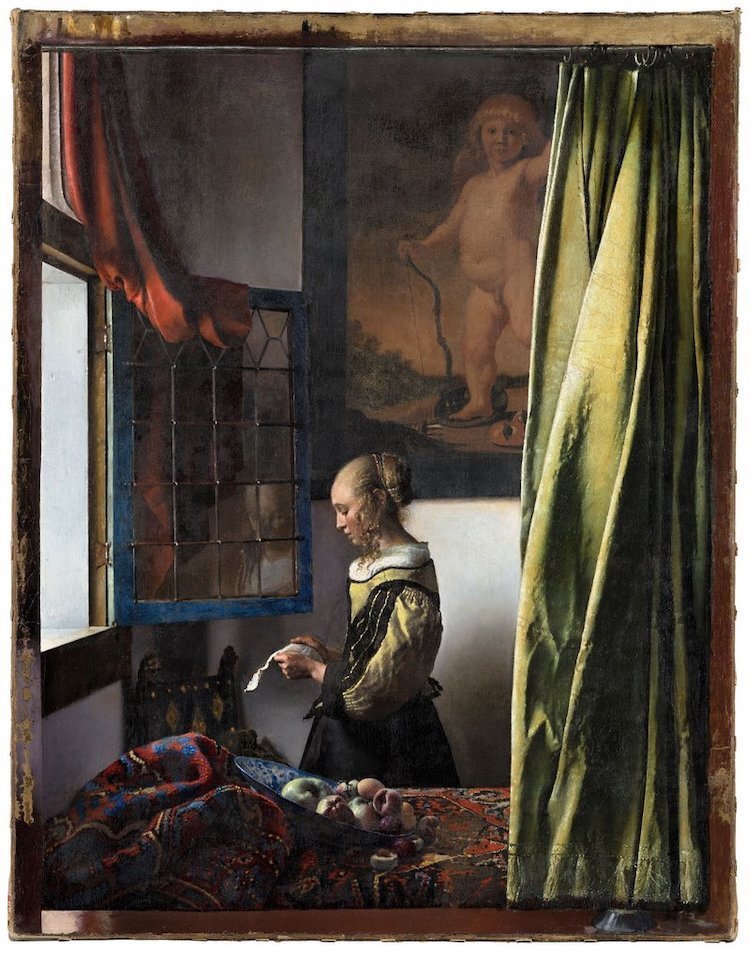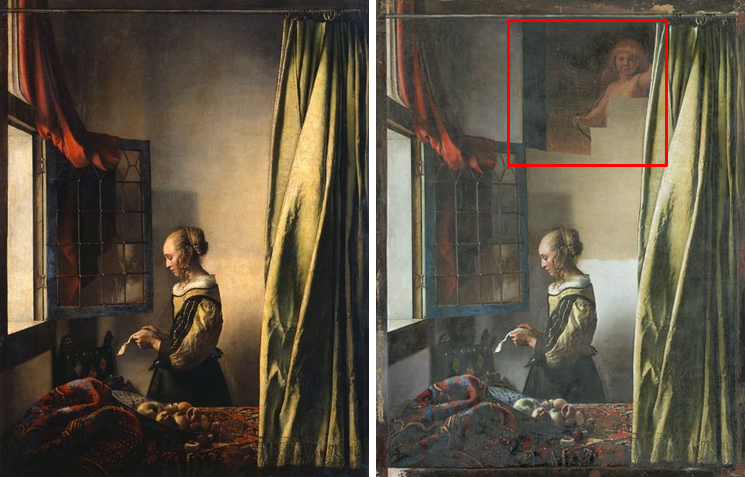Hidden Cupid Portrait Uncovered In 350-Year-Old Vermeer Painting Restoration
Uncover the hidden cupid portrait uncovered in 350-year-old Vermeer painting restoration that's rewriting art history.
Author:Xander OddityReviewer:Dr. Felix ChaosphereSep 20, 202312.4K Shares271.6K Views

Art history has been rewritten, thanks to a groundbreaking restoration project led by the Staatliche Kunstsammlungen Dresden in Germany. Johannes Vermeer, the enigmatic Dutch artist known for a scant portfolio of 34 masterpieces like "Girl with the Pearl Earring," is making headlines once again.
The restoration process has uncovered a hidden cupid portrait uncovered in 350-year-old Vermeer painting restoration fundamentally altering our understanding of the artwork and the artist's intent.
The Backstory
"Girl Reading a Letter at an Open Window" was painted between 1657 and 1659 and has been a part of the Dresden museum's collection since 1742. Originally attributed to other artists, the painting gained its proper credit when French art critic Théophile Thoré-Bürger identified it as a Vermeer in 1880.
It shows a young woman, dressed in a striking yellow and black ensemble, deeply engrossed in reading a letter next to an open window.
The wall behind the woman was believed to be blank until an X-ray scan in 1979 revealed a hidden painting of Cupid. Initially, art historians thought that Vermeer had decided to paint over it, but cutting-edge research from 2017 indicated otherwise.
Cutting-edge technological tools have enabled researchers to discoverthat the extra layer of paint covering Cupid was applied many years after the original painting was finished. This new finding calls into question previous interpretations of the artwork.
A New Perspective On Vermeer’s Vision
The hidden cupid portrait uncovered in 350-year-old Vermeer painting restorationwas restored by experts who took on the laborious task of unveiling Cupid in 2018. Upon completion in early 2021, the restored painting presented a profound shift in interpretation.
Stephan Koja, director of the Old Masters Picture Gallery, explained the implications: “Restoring the Cupid in the background shows us the master from Delft's true intention. Beyond the superficial romantic context, it makes a fundamental statement on the nature of true love. Until now, we could only see this as a fragment. Now we know what a key role it plays in his oeuvre.”
Koja also notes that "Girl Reading a Letter at an Open Window" can be viewed as the initiation of a series of paintings where Vermeer focuses on women in contemplative moments.
The Scientific Lens - X-Ray Imaging In Art Restoration
The use of X-ray imaging techniques, notably synchrotron radiation, has become an invaluable tool for art historians. Such nondestructive techniques have previously helped scientists reconstruct hidden paintings by Vincent van Gogh and determine the cause of degradation in Edvard Munch's "The Scream."
In the case of Vermeer's painting, advanced X-ray methods were crucial in revealing that the overpainting of Cupid was done decades after the original work, effectively nullifying the notion that Vermeer himself had covered the figure.
Subsequent analyses indicate that the overpainting of Cupid occurred a long time after Vermeer completed "Girl Reading a Letter," making it unlikely that Vermeer himself was responsible for covering the figure.
Technique And Material - A Deeper Dive Into Vermeer's Mastery
Vermeer's artistry goes beyond the surface, literally. This painting is one of the earliest-known examples to showcase his use of pointillé—a technique involving the use of tiny paint dots to manipulate light effects.
While the method has roots in the 15th-century decoration of armor and firearms, Vermeer's innovative usage hints at the potential employment of optical aids, although this remains a point of contention among historians.
Paint samples analyzed in the 1960s revealed that Vermeer used conventional pigments of the Baroque era, including blue azurite and lead-tin yellow. The painting underwent various examinations, including infrared reflectography and macro X-ray fluorescent scanning, before the recent restoration.
Conservationist Christoph Scholzel removed multiple layers of varnish that had turned yellowish-brown over time and noticed the paints used in the area where Cupid was hidden had different solubility properties than the other areas.
The New Image - What It All Means For Art History
According to Uta Neidhardt, the museum's head conservator and exhibition curator, the removal of the overpainting offers an opportunity to rethink the painting's composition. “The borders appear curiously unfinished—perhaps Vermeer covered it with an actual wooden frame, which is why he left them in such an 'open' condition,” she observed.
The newly revealed image depicts Cupid, the god of love and desire, holding a bow and flanked by two masks that possibly signify deception. The revelation enhances the painting's theme of true love and faithfulness, offering audiences a fuller understanding of Vermeer’s original vision.
"It is in 'Girl Reading a Letter' that Vermeer discovers his own, distinct style. It marks the beginning of a series of paintings in which individuals, generally women, pause during an activity to find a moment of calm, and to reflect," adds Stephan Koja.
A Deeper Appreciation Of Vermeer's Artistic Genius
In a world where Johannes Vermeer's life and art remain enigmatic, the uncovering of a long-hidden Cupid marks a significant step towards unraveling the mysteries behind his creative prowess. It reaffirms that every layer of paint in an artwork can hold a story, a vision, and a piece of the artist's soul that may only be appreciated centuries later.
The Staatliche Kunstsammlungen Dresden is celebrating this newfound appreciation for Vermeer's artistic vision with a special exhibition. Named "Johannes Vermeer. On pausing," the exhibit runs from September 10, 2021, to January 2, 2022, and prominently features the restored painting among nine other related Vermeer artworks.
In the often mysterious world of art, the unveiling of a hidden Cupid in a Vermeer painting adds another layer to the narrative. By employing cutting-edge scientific tools and art history expertise, the Staatliche Kunstsammlungen Dresden has enriched our understanding not only of this particular masterpiece but also of the broader context in which Johannes Vermeer created his iconic works. The restored painting serves as a testament to the intricacies of art, offering a new lens through which to appreciate the Dutch master’s legacy.
Frequently Asked Questions
How Was The Art Restoration Process Conducted To Reveal The Hidden Cupid In The 350-year-old Vermeer Painting?
The Staatliche Kunstsammlungen Dresden led a meticulous art restoration project that began in 2018. Advanced imaging techniques like X-ray and synchrotron radiation were used to safely remove layers of paint and unveil the hidden portrait of Cupid.
How Does This Restoration Contribute To Our Understanding Of The Dutch Golden Age?
The unveiling of Cupid in the painting provides a new lens through which to study the Dutch Golden Age, offering a more nuanced understanding of Vermeer's thematic choices and artistic context during this period.
What Role Did Stephan Koja Play In The Discovery?
Stephan Koja, the director of the Old Masters Picture Gallery, provided insights into the painting's new interpretation, explaining that it offers a "fundamental statement about the nature of true love."
Why Was Synchrotron Radiation Important In This Restoration?
Synchrotron radiation was crucial in determining the layers of paint and the timeframes in which they were applied, thus guiding the restoration process.
What Were The Technological Advancements Used In The Restoration?
Technologies such as X-ray imaging, synchrotron radiation, infrared reflectography, and macro X-ray fluorescent scanning were employed.
What Does The Painting Reveal About Vermeer's Mastery Of Technique And Material?
This painting is one of the earliest examples to showcase Vermeer's use of pointillé, a technique involving the use of tiny paint dots to manipulate light effects.
What Other Artists Have Had Hidden Images Discovered In Their Paintings?
Artists like Vincent van Gogh and Leonardo da Vinci have also had hidden images or layers discovered in their works through similar restoration techniques.
What Impact Has This Discovery Had On Art History?
The restoration has fundamentally altered our understanding of the painting and Vermeer's intent, reaffirming that every layer of paint can hold a significant story or vision.
What Are The Themes Highlighted In The Newly Revealed Image Of Cupid?
The image of Cupid holding a bow and flanked by two masks possibly signifies deception, thus enriching the painting's original theme of true love and faithfulness.
How Does This Restoration Affect The Value Of The Painting?
While it's difficult to quantify, the discovery certainly adds to the painting's historical and cultural significance, likely enhancing its value as well.
Why Did The Painting Undergo Various Examinations Before The Recent Restoration?
Prior examinations were conducted to understand the painting's condition, the types of pigments used, and the feasibility of restoring it.
What Does This Discovery Mean For The Field Of Conservation?
This restoration serves as a milestone, demonstrating the effectiveness of modern scientific techniques in art conservation.
What Did The Special Exhibition "Johannes Vermeer. On Pausing" Feature?
The special exhibition, which ran from September 10, 2021, to January 2, 2022, prominently featured the restored painting among nine other related Vermeer artworks.
What Are The Broader Implications For Understanding Vermeer's Portfolio?
The restoration offers new insights into Vermeer's thematic focus and artistic techniques, prompting a reevaluation of his entire body of work.
How Does The Newly Revealed Cupid Interact With The Painting's Main Subject?
The presence of Cupid in the background adds depth and nuance to the painting's theme, offering a fuller understanding of the emotional context in which the young woman reads her letter.
Conclusion
The hidden cupid portrait uncovered in 350-year-old Vermeer painting restoration serves as a monumental revelation in the art world, challenging long-standing interpretations and offering new insights into the Dutch master's artistic vision. This groundbreaking discovery not only enhances our understanding of the painting itself but also offers a richer contextual backdrop against which to appreciate Johannes Vermeer's legacy.
It reminds us that artworks are multi-dimensional treasures, concealing stories and meanings that may only come to light centuries later, through the confluence of cutting-edge technology and scholarly investigation.
Jump to
The Backstory
A New Perspective On Vermeer’s Vision
The Scientific Lens - X-Ray Imaging In Art Restoration
Technique And Material - A Deeper Dive Into Vermeer's Mastery
The New Image - What It All Means For Art History
A Deeper Appreciation Of Vermeer's Artistic Genius
Frequently Asked Questions
Conclusion

Xander Oddity
Author
Xander Oddity, an eccentric and intrepid news reporter, is a master of unearthing the strange and bizarre. With an insatiable curiosity for the unconventional, Xander ventures into the depths of the unknown, fearlessly pursuing stories that defy conventional explanation. Armed with a vast reservoir of knowledge and experience in the realm of conspiracies, Xander is a seasoned investigator of the extraordinary.
Throughout his illustrious career, Xander has built a reputation for delving into the shadows of secrecy and unraveling the enigmatic. With an unyielding determination and an unwavering belief in the power of the bizarre, Xander strives to shed light on the unexplained and challenge the boundaries of conventional wisdom. In his pursuit of the truth, Xander continues to inspire others to question the world around them and embrace the unexpected.

Dr. Felix Chaosphere
Reviewer
Dr. Felix Chaosphere, a renowned and eccentric psychiatrist, is a master of unraveling the complexities of the human mind. With his wild and untamed hair, he embodies the essence of a brilliant but unconventional thinker. As a sexologist, he fearlessly delves into the depths of human desire and intimacy, unearthing hidden truths and challenging societal norms.
Beyond his professional expertise, Dr. Chaosphere is also a celebrated author, renowned for his provocative and thought-provoking literary works. His written words mirror the enigmatic nature of his persona, inviting readers to explore the labyrinthine corridors of the human psyche.
With his indomitable spirit and insatiable curiosity, Dr. Chaosphere continues to push boundaries, challenging society's preconceived notions and inspiring others to embrace their own inner tumult.
Latest Articles
Popular Articles
